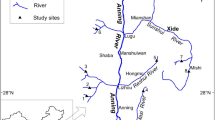Abstract
The diets of 441 catfish Synodontis zambezensis from three different localities in Lake Kariba were analysed. S. zambezensis was found to be primarily a molluscivore, acitively selecting the pulmonate Lymnaea natalensis and chironomid larvae in 59% and 30% of the cases, respectively. Although highly selective, S. zambezensis changed its prey preference according to availability of prey species. Some changes in diet were associated with the emergences of insects such as the flying form of the termite Aletes sp. The range of food items found in the stomachs suggested that the range of fish can also use other food items effectively. The Percent Similarity Index showed significant temporal differences in diet. Evidence showed that S. zambezensis was a benthic feeder but also fed at the water surface. No dietary shifts from the smallest fish (12 cm) to the largest fish caught (38 cm) were observed. However, specimens under 20 cm total length were few and this could have influenced the results. S. zambezensis is an ‘oral sheller’ that removes gastropod shells prior to swallowing the soft tissue and either discards or swallows the smaller shells (< 10 mm height). The results showed that the S. zambezensis does not have a strict food regime and this gives it a better change of becoming widely distributed. There is a high possibility that the food composition will vary as the food abundances and distributions in the lake shift and S. zambezensis is likely to be little affected. Ecological it is important that the squeaker is feeding on a resource which is hardly utilized in the lake.
Similar content being viewed by others
References
Assis, C. A., P. R. Almeida, F. Moreira, J. L. Costa & M. J. Costa, 1992. Diet of the twaite shad Alosa fallax (Lacepede) (Clupeidae) in the River Tagus Estuary, Portugal. J. Fish Biol. 41: 1049–1050.
Bishai, H. M. & Y. B. A. Gideiri, 1965. Studies on the biology of the genus Synodontis at Khartoum. 2. Food and feeding habits. Hydrobiologia 6: 98–113.
Bowmaker, A. P., 1968. Some upper Congo fish which offer a means of biological control of the snail vectors of Bilharziasis. Proc.Trans. Rhod. Scient. Ass. 52: 28–37.
Bowmaker, A. P., 1973. The fish. Food and Feeding. A Hydrobiological study of the Mwenda River and its mouth, Lake Kariba. PhD theses, University of Witwatersrand, South Africa: 486–490.
Brown, D., 1980. Freshwater Snails of Africa and their Medical Importance. Taylor & Francis (Printers) Ltd. London, 487 pp.
Chesson, J., 1983. The estimation and analysis preference and its relationship to foraging models. Ecology 64: 1297–1304.
Colwell, R. K. & D. J. Futuyma, 1971. On measurement of niche breadth and overlap. Ecology 52: 567–576.
Cowen, R. K., 1986. Site-specific differences in the feeding ecology of the California sheepshead Semicossyphus pulcher (Labridae) Envir. Biol. Fishes 161: 193–203.
Coulter G. W.,1991. The benthic fish community. In G. W. Coulter (ed.), Lake Tanganyika and its Life. Oxford University Press, Oxford: 181–182.
Daget, J., Gosse J. P. & G. G. Teugel, 1991. (eds) Checklist of the Freshwater fishes of Africa (CLOFFA). Vol 4, 740 pp. Paris: Orstom-MRAC.
Hynes, H. B. N., 1950. The food of freshwater sticklebacks (Gasterosteus aculeatus and Pygosteus pungitius), with a review of the methods used in the study of the food of fishes. J. anim. Ecol. 19: 36–58.
Jackson, P. B. N., 1961. Ichthyology. The fish of the Middle Zambezi. Kariba Studies 1: 1–36.
Kenmuir, D. H. S., 1984. Fish population changes in the Sanyati Basin, Lake Kariba, Zimbabwe. S. Afr. J. Zool. 19: 194–209.
King, B., 1993. Ecological Studies on the intermediate hosts of human Schistosomiasis in Lake Kariba. M. Phil. thesis. University of Zimbabwe.
Lock, J.M., 1982. The biology of Siluriform fishes in Lake Turkana. In A. J. Hopson (ed.), Lake Turkana: A Report on the Findings of Lake Turkana. Overseas Development Administration. 4: 1021–1281.
Lowe-McConnel, R. H., 1987. Trophic Interrelationships. In R.H Lowe-McConnell (ed.), Ecological Studies in Tropical Fish Communities. Cambridge University Press, Cambridge: 270–286.
Machena, C. & N. Kautsky, 1988. A quantitative diving survey of benthic vegetation and fauna in lake Kariba, a tropical man-made lake. Freshwat. Biol. 19: 1–14.
McLachlan, A. J., 1969. The effect of aquatic macrophytes on the variety and abundance of benthic fauna in a newly created lake (Lake Kariba). Arch. Hydrobiol. 66: 212–231.
Michell, S. A., 1976. The marginal fish fauna of Lake Kariba. Kariba Studies 8: 109–162.
Mitchell, S. A., 1978. The diurnal activity patterns and depth zonation of marginal fish as shown by gill-netting in Lake Kariba. Kariba Studies 9: 163–173.
Moyo, N. A. G., 1994. The feeding behaviour of Sargochromiscodringtoni in Lake Kariba. PhD. Thesis. University Waterloo, Canada: 17–133.
Pianka, E. R., 1981. Competition and niche theory. In R. M. May (ed.), Theoretical Ecology: Principles and Applications. Blackwell Scientific Publications, Oxford: 167–196.
Pinkas, L., M. S. Oliphant & Iverson 1971. Food habits of albacore, bluefin tuna and bonito in Californian waters. Fish. Bull. Calif. Fish. Game 152: 1–105.
Sanyanga, R. A., 1996. Variantions in abundance of Synodontis zambezensis (Pisces: Mochokidae) Peters 1852, In the inshore fishery of Lake Kariba. Fish. Res. 26: 171–186.
Willoughby, N. G., 1974. Food and feeding. The ecology of the genus Synodontis Pisces: Silurodei in Lake Kainji, Nigeria. PhD Thesis University of Southampton, England: 149–196.
Windell, J. T., 1971. Food analysis and role of digestion. In W. E. Ricker (ed.), Methods for Assessment of Fish Production in Fresh Waters. 2nd edn. Blackwell Scientific Publications, Oxford: 215–226.
Windell, J. T. & S. H. Bowen, 1978. Methods of Study of Fish Diets Based on Analysis of Stomach Contents. In T. Bagenal (ed.), Methods for Assessment of Fish Reduction in Fresh Waters, IPB Handbook no. 3. Blackwell Scientific Publications, London: 219–226.
Author information
Authors and Affiliations
Rights and permissions
About this article
Cite this article
Sanyanga, R.A. Food composition and selectivity of Synodontis zambezensis (Pisces: Mochokidae) in Lake Kariba, and the ecological implications. Hydrobiologia 361, 89–99 (1997). https://doi.org/10.1023/A:1003101813361
Issue Date:
DOI: https://doi.org/10.1023/A:1003101813361




